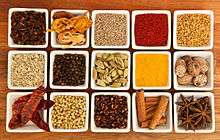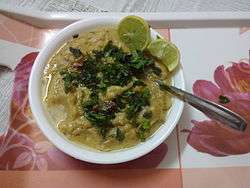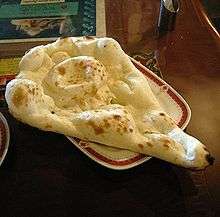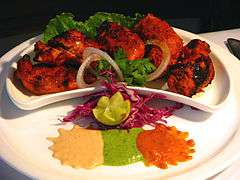Hyderabadi haleem
|
Homemade Hyderabadi haleem | |
| Alternative names | Hyderabadi Harees |
|---|---|
| Place of origin | India |
| Region or state | Hyderabad |
| Creator | Originated from the Chaush (Hyderabadi Arabs)[1] |
| Main ingredients | Pounded wheat, lentils, goat meat, ghee, dried fruit and saffron |
|
| |
 |
| This article is part of the series |
| Indian cuisine |
|---|
|
Regional cuisines
|
|
Ingredients, types of food |
|
See also
|
|
Hyderabadi haleem (/ˈhaɪdərəbædɪˈhæliːm/) is a type of haleem popular in the Indian city Hyderabad. Haleem is a stew composed of meat, lentils and pounded wheat made into a thick paste. It is originally an Arabic dish and was introduced to the Hyderabad State by the Chaush people during the rule of the Nizams (the former rulers of Hyderabad State). Local traditional spices helped in evolving a unique Hyderabadi haleem that became popular among the native Hyderabadi Muslims by the 19th-century.
The preparation of haleem has been compared to that of Hyderabadi biryani. Though Hyderabadi haleem is the traditional hors d'oeuvre at weddings, celebrations and other social occasions, it is particularly consumed in the Islamic month of Ramadan during Iftar (the evening meal that breaks the day-long fast) as it provides instant energy and is high in calories. This has made the dish synonymous with Ramadan. In recognition of its cultural significance and popularity, in 2010, it was granted Geographical Indication status (GIS) by the Indian GIS registry office, making it the first non-vegetarian dish in India to get this status.
History
Haleem originated as an Arabic dish[1][2] with meat and pounded wheat as the chief ingredients. It was introduced to Hyderabad by the Arab diaspora during the rule of the sixth Nizam, Mahbub Ali Khan, and later became an integral part of Hyderabadi cuisine during the rule of the seventh Nizam, Mir Osman Ali Khan.[3][4] Sultan Saif Nawaz Jung Bahadur, an Arab chief from Al Mukalla, Hadhramaut, Yemen, who was among the seventh Nizam's court nobility, popularised it in Hyderabad.[1][5] Addition of local flavours to the original recipe resulted in a taste distinct from other types of haleem.[6]
Preparation
Traditionally, Hyderabadi haleem is cooked on a low flame of firewood for up to 12 hours in a bhatti (a cauldron covered with a brick and mud kiln). One or two people are required to stir it continuously with wooden paddles throughout its preparation. For home-made Hyderabadi haleem, a Ghotni (a wooden hand masher) is used to stir it until it reaches a sticky-smooth consistency, similar to mashed mince.[7][8]
Ingredients

The ingredients include meat (either goat meat, beef or chicken); pounded wheat; ghee—(milk fat rendered from butter, also called clarified butter); milk; lentils; ginger and garlic paste; turmeric; spices such as cumin seeds, caraway seeds (shah zeera), cinnamon, cardamom, cloves, black pepper, saffron, jaggery, natural gum, allspice (kabab cheeni); and dry fruits such as pistachio, cashew, fig and almond. It is served hot topped with a ghee-based gravy, pieces of lime, chopped coriander, sliced boiled egg and fried onions as garnish.[3][9][10][11]
Variations
Different variants have been introduced catering to regional taste and requirements. A meethi (sweet) variant of haleem is consumed as breakfast by the Arab diaspora in Barkas neighbourhood of the city.<ref "name=thefreelibrary.com">"Barkas Street, a little Arabia in Hyderabad". thefreelibrary.com. Retrieved 30 August 2011.</ref> The chicken variant is less popular, even though it is lower priced. A vegetarian version of haleem, in which dry fruits and vegetables are substituted for goat meat, is available at some eateries in Hyderabad.[12]
Nutrition
|
|
Hyderabadi haleem is a high calorie dish which gives instant energy as it contains slow-digesting and fast-burning ingredients.[13][14] It also contains dry fruits rich in anti-oxidants.[9][15] The meat and dry fruits make it a high protein food. A new low-cholesterol variety by using emu meat, rich in minerals, phosphorus and vitamins, was introduced in 2013.[16][17] The Greater Hyderabad Municipal Corporation (GHMC), a local civic body that monitors health and safety regulations in the city, has set up hygiene and quality standards to be followed by the eateries selling it.[18]
Popularity
Hyderabadi haleem is regarded as an international delicacy.[19][20] In Hyderabad, the dish is often consumed at celebratory events such as weddings.[13] It is consumed especially during Iftaar, the evening meal following the day-long fast, observed by Muslims during the month of Ramadan.[21][22]
In Hyderabad and neighbouring areas, the month of Ramadan is synonymous with Hyderabadi haleem.[23] During the 2014 Ramadan season, ₹5 billion worth of Hyderabadi haleem was sold in the city,[24] and an additional 25,000 people were employed in the preparation and sale of haleem.[25] The connoisseur chefs are paid salaries of up to ₹100,000 (US$1,500) a month plus benefits,<ref "name=siasat">"Hyderabadi Haleem treat for Vijayawadians". The Siasat Daily. 2 August 2011. Retrieved 24 August 2011.</ref> As of 2011, during Ramadan there were 6,000 eateries throughout the city that sold haleem (70% of which are temporary until Ramadan ends),[26][27] and 28% of Hyderabadi haleem produced in the city was exported to 50 countries throughout the world.[26]
Sanjeev Kapoor, an entrepreneur of Indian cuisine, mentions in his book Royal Hyderabadi Cooking that the preparation of haleem in Hyderabad has become an art form, much like the Hyderabadi biryani.[28] In 2010 Hyderabadi haleem was awarded Geographical Indication status by the Indian GI registry office. It became the first meat product of India to receive a GI certification,[14][29] This means that a dish cannot be sold as Hyderabadi haleem unless it meets the necessary standards laid down for it.[27][30]
See also
References
- 1 2 3 Shahid, Sajjad (16 August 2011). "Biryani, Haleem & more on Hyderabad's menu". The Times of India. Retrieved 18 August 2011.
- ↑ "Ramadan, the month of unprecedented shopping in Hyderabad". Overseas Indian. Ministry of Overseas Indian Affairs, Government of India. October 2006. Retrieved 10 July 2012.
- 1 2 Siddique, Mohammed (18 August 2010). "In Hyderabad this Ramzan? Try the Haleem". Rediff. Retrieved 24 August 2010.
- ↑ Dey, Pranesh (5 December 2004). "How the city succumbed to a new taste". The Times of India. Retrieved 24 August 2011.
- ↑ Nanisetti, Serish (10 June 2016). "How haleem conquered Hyderabadi hearts". The Hindu. Retrieved 10 June 2016.
- ↑ Karen Isaksen Leonard (2007). Locating home: India's Hyderabadis abroad. stanford university press. p. 14. ISBN 978-0-8047-5442-2. Retrieved 19 September 2011.
- ↑ Vyas, Sheetal (12 September 2010). "Deccan delight". Sify. Retrieved 25 August 2013.
- ↑ "Hyderabadi Haleem to go global, outlets in US planned (Business Feature)". Business Standard. 29 July 2013. Retrieved 25 August 2013.
- 1 2 "Haleem boosts sex life". The Times of India. 14 August 2011. Retrieved 29 August 2010.
- ↑ "Famous Hyderabadi Haleem dish gets patented". Gulf News. 3 September 2010. Retrieved 3 June 2013.
- ↑ Latif, Bilkees I. (1999). The Essential Andhra Cookbook with Hyderabadi Specialities. Penguin Books (India). pp. 95–97. ISBN 978-0-14-027184-3.
- ↑ "Get ready for veg haleem". The Times of India. 26 October 2003. Retrieved 29 August 2010.
- 1 2 "My love affair with the Haleem began during Ramzan". The Sunday Guardian. 17 June 2012. Retrieved 17 June 2012.
- 1 2 "Hyderabad Haleem' gets Geographical Indication certification". Indian Council of Agricultural Research. 2010. Retrieved 21 June 2012.
- ↑ "The Hyderabad haleem is now a Rs 100-crore brand name". Deccan Herald. 18 June 2012. Retrieved 18 June 2012.
- ↑ Jayaram, P S (22 July 2013). "Hyderabadi haleem is now low-cholesterol". Khaleej Times. Retrieved 7 August 2013.
- ↑ Radhakrishna, G S (20 July 2013). "Meat of ostrich cousin low in fat". The Telegraph (India). Retrieved 7 August 2013.
- ↑ "Haleem on the radar". Post Noon. 10 July 2013. Retrieved 7 August 2013.
- ↑ Ciezadlo, Annia (30 January 2012). "Haute bedouin cuisine with Mezlai's Ali Ebdowa". The Daily Beast. Retrieved 19 June 2012.
- ↑ Davidson, Alan (1981). Food in Motion: The Migration of Foodstuffs and Cookery Techniques. Oxford Symposium. p. 77. ISBN 978-0-907325-07-9.
- ↑ Saqaf, Syed Muthahar (21 September 2009). "'Nonbu Kanji,' a noble thing that paves way for communal harmony". The Hindu. Retrieved 20 June 2012.
- ↑ Alluri, Aparna (10 August 2012). "Hyderabad's Charm Found in Ramadan Delights". The New York Times. Retrieved 3 June 2013.
- ↑ "Hyderabadi haleem now a click away". Rediff. 14 September 2007. Retrieved 28 May 2012.
- Jatania, Prachi (13 October 2006). Get a taste of Hyderabadi haleem. IBN Live. Retrieved 24 August 2011.
- "Haleem days are here again". The Hindu. 26 September 2006. Retrieved 21 May 2012.
- ↑ Nemana, Vivekananda (21 July 2014). "... How Haleem Got All Hot and Heavy in Hyderabad". Yahoo! News. Retrieved 21 July 2014.
- ↑ "Mumbaiites get Haleem-ed". MiD DAY. 8 August 2012. Retrieved 8 May 2013.
- 1 2 "Taste and wealth". Business Standard. 20 August 2011. Retrieved 19 June 2012.
- 1 2 Hyderabadi Haleem now close to being patented. NDTV. 2 September 2010. Retrieved 24 August 2010.
- ↑ Kapoor, Sanjeev (2008). Royal Hyderabadi Cooking. Popular Prakashan. p. 3. ISBN 978-81-7991-373-4.
- ↑ "Geographical indications journal no:37" (PDF). Government of India. 4 January 2011: 9. Retrieved 18 June 2012.
- ↑ Hyderabadi haleem now officially an asset of AP. IBN Live. 2 October 2010. Retrieved 24 August 2011.
- "Culture:The original 'slow food' staple: A GI tag for the iconic Hyderabadi dish is reason to raise a toast". Mint (newspaper) and The Wall Street Journal. 10 September 2010. Retrieved 24 August 2011.
Further reading
- Pratibha Karan (1998). A Princely Legacy: Hyderabadi Cuisine. India: Harper Collins Publishers. ISBN 978-81-7223-318-1.
- Asema Moosavi (1995). Elegant East Indian and Hyderabadi Cuisine. Hyderabad: Deccan Snacks & Foods. ISBN 0-9699523-0-9.
- Bilkees Latif (1999). The Essential Andhra Cookbook with Hyderabadi Specialties. United Kingdom: Penguin Books. ISBN 978-0-14-027184-3.
External links
| Wikimedia Commons has media related to Hyderabadi Haleem. |
| Wikibooks Cookbook has a recipe/module on |



